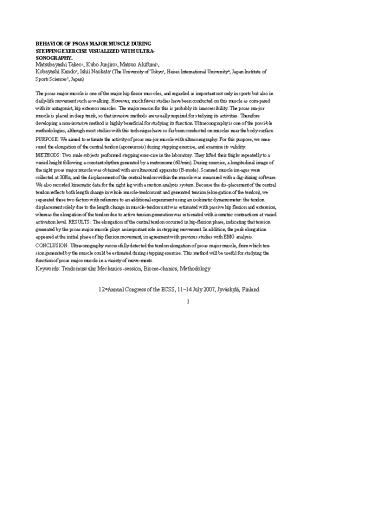BEHAVIOR OF PSOAS MAJOR MUSCLE DURING PowerPoint PPT Presentation
1 / 1
Title: BEHAVIOR OF PSOAS MAJOR MUSCLE DURING
1
BEHAVIOR OF PSOAS MAJOR MUSCLE DURING STEPPING
EXERCISE VISUALIZED WITH ULTRA- SONOGRAPHY.
Matsubayashi Takeo1, Kubo Junjiro2, Matsuo
Akifumi3, Kobayashi Kando1, Ishii Naokata1 (The
University of Tokyo1, Heisei International
University2, Japan Institute of Sports Sciences3,
Japan) The psoas major muscle is one of the
major hip flexor mus-cles, and regarded as
important not only in sports but also in
daily-life movement such as walking. However,
much fewer studies have been conducted on this
muscle as com-pared with its antagonist, hip
extensor muscles. The major reason for this is
probably its inaccessibility. The psoas ma-jor
muscle is placed in deep trunk, so that invasive
methods are usually required for studying its
activities. Therefore developing a non-invasive
method is highly beneficial for studying its
function. Ultrasonography is one of the possi-ble
methodologies, although most studies with this
tech-nique have so far been conducted on muscles
near the body surface. PURPOSE We aimed to
estimate the activity of psoas ma-jor muscle with
ultrasonography. For this purpose, we mea-sured
the elongation of the central tendon
(aponeurosis) during stepping exercise, and
examine its validity. METHODS Two male subjects
performed stepping exer-cise in the laboratory.
They lifted their thighs repeatedly to a varied
height following a constant rhythm generated by a
metronome (60/min). During exercise, a
longitudinal image of the right psoas major
muscle was obtained with an ultrasound apparatus
(B-mode). Scanned muscle im-ages were collected
at 30Hz, and the displacement of the central
tendon within the muscle was measured with a
dig-itizing software. We also recorded kinematic
data for the right leg with a motion analysis
system. Because the dis-placement of the central
tendon reflects both length change in whole
muscle-tendon unit and generated tension
(elon-gation of the tendon), we separated these
two factors with reference to an additional
experiment using an isokinetic dynamometer the
tendon displacement solely due to the length
change in muscle-tendon unit was estimated with
passive hip flexion and extension, whereas the
elongation of the tendon due to active tension
generation was esti-mated with isometric
contractions at varied activation level. RESULTS
The elongation of the central tendon occurred in
hip-flexion phase, indicating that tension
generated by the psoas major muscle plays an
important role in stepping movement. In addition,
the peak elongation appeared at the initial phase
of hip flexion movement, in agreement with
previous studies with EMG analysis. CONCLUSION
Ultrasonography successfully detected the tendon
elongation of psoas major muscle, from which
ten-sion generated by the muscle could be
estimated during stepping exercise. This method
will be useful for studying the function of psoas
major muscle in a variety of move-ments.
Keywords Tendomuscular Mechanics -session,
Biome-chanics, Methodology 12thAnnual Congress
of the ECSS, 1114 July 2007, Jyväskylä, Finland
I

